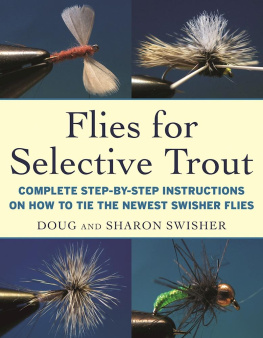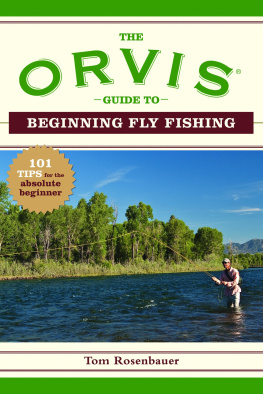
For Ophelia and Bennett, two future fly fishers.

Copyright 2014 by Skyhorse Publishing.
All rights reserved. No part of this book may be reproduced in any manner without the express written consent of the publisher, except in the case of brief excerpts in critical reviews or articles. All inquiries should be addressed to Skyhorse Publishing, 307 West 36th Street, 11th Floor, New York, NY 10018.
Skyhorse Publishing books may be purchased in bulk at special discounts for sales promotion, corporate gifts, fund-raising, or educational purposes. Special editions can also be created to specifications. For details, contact the Special Sales Department, Skyhorse Publishing, 307 West 36th Street, 11th Floor, New York, NY 10018 or .
Skyhorse and Skyhorse Publishing are registered trademarks of Skyhorse Publishing, Inc., a Delaware corporation.
www.skyhorsepublishing.com
10 9 8 7 6 5 4 3 2 1
Library of Congress Cataloging-in-Publication Data
Klausmeyer, David, 1958
101 favorite nymphs & wet flies: history, tying tips, and fishing strategies/by David Klausmeyer.
pages cm
ISBN 978-1-62873-748-6 (pbk.: alk. paper) 1. Flies, Artificial. 2. Fly tying. 3. Nymphs (Insects) I. Title. II. Title: One hundred one nymphs and wet flies.
SH451.K52 2014
688.7'9124dc23
2014015792
ISBN: 978-1-62873-748-6
eISBN: 978-1-62914-114-5
Cover Design by Owen Corrigan
Cover Photo by David Klausmeyer
Printed in China
Contents
Introduction
The Advantages of Fishing Wet
THERE ARE SEVERAL DISTINCT ADVANTAGES TO FISHING wet. No, I dont mean being soaked from the rain or from falling into the river. I mean that there are benefits to fishing with wet flies and nymphs. In fact, compared to fishing with dry flies, I dare say that you will usually catch more trout using subsurface patterns.
I love fishing dry flies to rising trout, but lets be real: most of the time the insects are not hatching and the fish are not rising. This doesnt mean that the trout are not feeding. They are simply eating the food they find below the surface of the water. And thats the rub for anglersexcept in rare circumstances, its impossible to see exactly what the fish are feeding on. This problem is even more challenging when we are fishing still waters and the trout are cruising far below the surface.
Successful anglers who consistently catch the most fish spend time deciphering the mystery of how trout feed subsurface. They learn about a trouts preferred foods and how it eats them. They use this hard-earned knowledge to refine their fishing tactics and design new fly patterns. The participants to the World Fly Fishing Championship are among the leaders in this studious approach to angling. Sure, controversy surrounds the idea of competitive fly fishing. But make no mistake: these anglers know how to catch large numbers of fish, and we can learn a lot from them.
Most of the new fishing methods and patterns coming out of the World Fly Fishing Championship involve nymphs and wet flies. I dont think this is because there are no new dry flies or streamers to create. It is because these anglers know that they will almost always catch more fish using small subsurface flies. They use this information to their advantage and so should we.
This little book contains 101 terrific wet flies and nymphs, spanning more than a century of fly-fishing history. Some of these patterns are well known, but others have never appeared in print. All are guaranteed to catch fish.
Enjoy these flies and discover the advantages of fishing wet.
David Klausmeyer
Spring 2014

CHAPTER ONE

Timeless
Wet Flies
Bergman Fontinalis

Hook: Regular wet-fly hook, sizes 10 to 2.
Thread: Black 8/0 (70 denier).
Tail: White, dark gray, and orange strips from duck or goose quill.
Body: Gray and orange wool yarn.
Hackle: Dark dun.
Wing: White, dark gray, and orange strips from duck or goose quill.
IN 1938, RAY BERGMAN PUBLISHED A BOOK TITLED TROUT . This fine book would anchor the angling libraries of fly fishers for many decades. There would eventually be several editions of Trout , and you can easily find a copy in a secondhand bookstore.
In addition to being chock-full of sound advice for catching trout, Trout included illustrations and recipes for several hundred wet flies. Fly tiers still enjoy making these patterns, and these flies still catch fish. If you are inclined to try your hand at dressing a few vintage flies, Trout will keep you very busy.
Ray Bergman really didnt design this pattern, called the Bergman Fontinalis; it was the creation of his friend, Phil Armstrong. Fontinalis, of course, refers to the brook trout ( Salvelinus fontinalis ). Legend has it that once upon a time, the fins of small brook trout were commonly used as bait to catch larger fish. Classic wet flies such as the Bergman Fontinalis, Parmacheene Belle, Fontinalis Fin, Trout Fineven the Royal Coachmanare supposed to imitate brook-trout fins.
I guess this was long before the catch-and-release ethic. Hey, dont blame meIm just reporting the story.
With respect to making the Bergman Fontinalis (Sharon E. Wright tied this perfect example of the pattern), the fly actually has two tails tied side-by-side, similar to the two wings of the fly. As a result, you will need six individual strips clipped from duck or goose quills; make each separate tail using three of the strips.

Cowdung

Hook: Regular wet-fly hook, sizes 16 to 12.
Thread: Orange 8/0 (70 denier).
Tag: Flat, old tinsel.
Body: Olive-orange rabbit dubbing. Some recipes recommend adding pinches of yellow and tan dubbing.
Wing: Cinnamon turkey.
Hackle: Brown.
WHAT CAN WE SAY ABOUT A FLY CALLED THE COWDUNG? Actually, quite a bit.
The name is not a comment about the color of the materials used in the fly, or some bit of odd, nineteenth-century humor. The Cowdung is actually an early attempt to match a terrestrialor land-borninsect.
There are several early references to the Cowdung, but here we will refer to The Sportsmans Gazetteer and General Guide: The Game Animals, Birds and Fishes of North America: Their Habits and Various Methods of Capture , which was published in 1877. According to the authors, Charles Hallock and Henry M. Reeves, real insects called cowdung flies (they even give the scientific Latin name, Scatophago stercoraria , which you will readily find in an online search) were used as bait for catching trout. The larvae of the cowdung feed on the manure of cows, and the pupae hibernate in the ground. Upon emerging, some of the adult insects get blown onto nearby streams and become fodder for the fish. Anglers noticed how the trout readily fed on these insects and used what they thought was a matching fly.



















